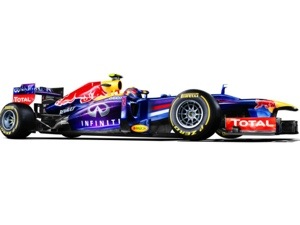Additive Manufacturing Helps Drive F1 Racing

Rapid prototyping plays an invaluable part in the R&D process for F1 race cars. Courtesy of Red Bull Racing.
Latest News
July 7, 2014
Every manufacturer is looking for ways to make 3D printing move faster, but Formula 1 racing is already moving faster thanks to 3D printing. Red Bull Racing and the Lotus F1 Team have both seized upon additive manufacturing (AM) as a way to improve race car performance. Each second shaved off a lap is another victory for the research team and can lead to actual victories on the track.
F1 design teams use AM for the rapid prototyping of new parts to be tested on 60% scale models in a wind tunnel. The use of 3D printing ensures a level of quality and accuracy for a price that can’t be matched by more traditional manufacturing processes. Speed is also a consideration. Instead of manufacturing new tools to build each prototype, the use of AM allows for quick turnaround times from conception to prototype, and multiple prototypes can be built simultaneously.
 Rapid prototyping plays an invaluable part in the R&D process for F1 race cars. Courtesy of Red Bull Racing.
Rapid prototyping plays an invaluable part in the R&D process for F1 race cars. Courtesy of Red Bull Racing.Along with general rapid prototyping and testing, the research teams look at ways specific designs can affect an F1 racer, accounting for differing weather conditions, track layouts, and even humidity.
“At the end of the year, we are approximately a second per lap quicker than when we started,” said Bob Bell, chassis technical director. “In motor racing, you can’t put a price on how much that is worth. Aerodynamics is easily the most cost-effective way to extract performance, and 3D Systems’ technologies are now an essential part of our aero development.”
While the research teams are currently focused on AM for prototyping, they are looking ahead to a time when materials and 3D printing technology have advanced to the point where it can be used for production. Occasionally, the research teams design a prototype part that can easily be produced using AM, but is a challenge to build for actual end-use.
Additionally, the Red Bull team foresees a day in which on-the-spot repairs can be made to damaged cars by using a 3D printer to build the required item. Instead of bringing a pile of replacement parts to the track, the pit crew could simply click on a needed part and print it out as their car was coming in for work. It’ll be a while before the teams can print out a new part quickly enough to make a difference, but that day is coming.
Below you’ll find a video featuring the Lotus F1 Team discussing how they put AM to work. You can also find information on how 3D printing is used to improve the performance of rally car racing here.
Sources: 3D Systems, Trusted Reviews
Subscribe to our FREE magazine, FREE email newsletters or both!
Latest News
About the Author
John NewmanJohn Newman is a Digital Engineering contributor who focuses on 3D printing. Contact him via [email protected] and read his posts on Rapid Ready Technology.
Follow DE





